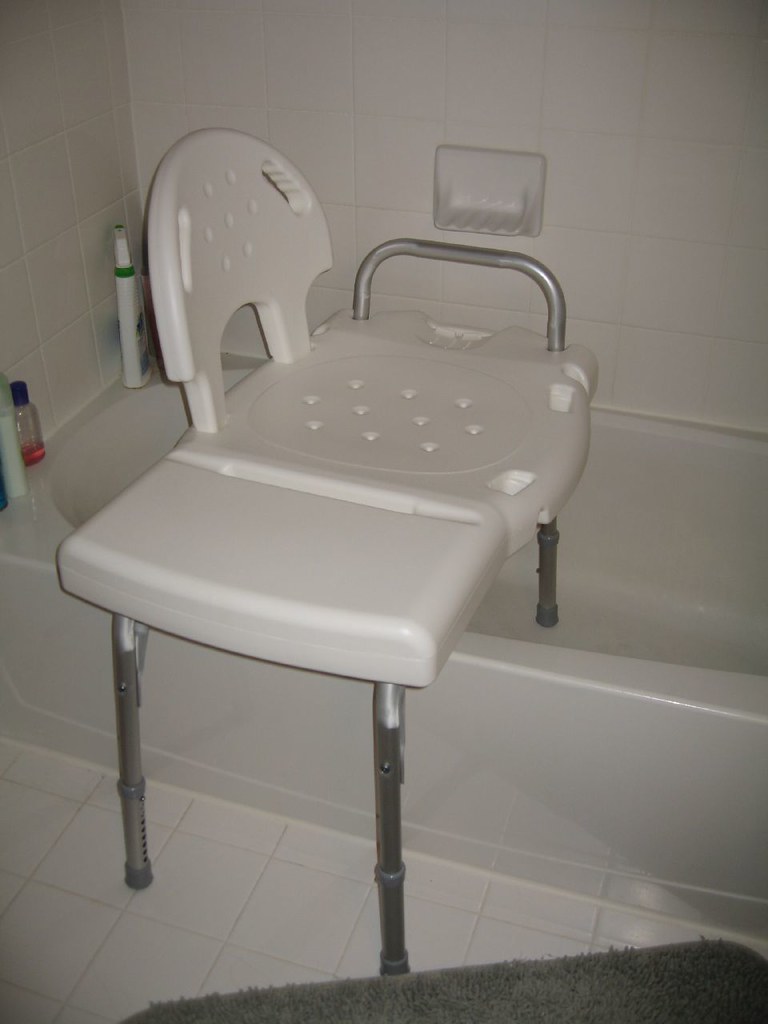5.6 Types of Baths and Techniques
There are four basic types of baths that are provided based on the needs, preferences, and mobility of clients: a partial bath, shower, tub bath, or full bed bath.
A partial bath includes washing the face, underarms, arms, hands, and perineal (genital and anal) area. Partial baths are given daily to maintain hygiene. They preserve skin integrity by not drying out skin with excessive soap and water use. A shower is provided for those who can safely sit in a shower chair or stand with supervision in the shower. See Figure 5.6[1] for an image of a shower chair with a transfer bench. A tub bath can be performed in a regular tub or whirlpool. A tub bath may be used for a fully independent resident or if there is a provider order for a bath treatment such as Epsom salts or oatmeal. A complete bed bath is a bath provided for clients who have difficulty getting out of bed, are experiencing excessive pain, or have other physical or cognitive issues that make other types of bathing less tolerable.

A resident has the right to choose any type of bath as long as it is safe to do so. A whirlpool bath can be relaxing and enjoyable for any resident, whereas a bed bath can maintain warmth while keeping the majority of the body covered.
If a resident is hesitant about bathing, different types of baths should be offered based on their preference. It is also possible to delay a scheduled bath to a different time of day or an alternate day, as long as their hygiene needs are being met. If a resident continues to be resistant to bathing, different approaches should be attempted until the person is comfortable and hygiene is maintained. Keep in mind that resistance to bathing can be common during the aging process, especially in clients with dementia as the disease progresses.
Visit the following site to read additional bathing techniques and products for unique situations: Bathing Without a Battle.
Considerations During Bathing
Nursing assistants should maintain privacy and comfort for those receiving assistance with bathing. Residents can become uncomfortable due to many factors during bathing. For example, if they require transportation to the shower area in the hallway on a shower chair, the chair can be uncomfortable or cold, or they may be concerned about being exposed. Bath blankets should be placed over the resident, paying attention to tucking the blanket behind the resident’s back and underneath their legs to keep any skin from showing. Residents should also wear shoes or socks to prevent any skin injuries to feet. A towel over the top of their head can assist in keeping them warm, and the shower chair can be padded around the seat with towels or washcloths. Often the seat back is made of mesh to aid in water drainage, which can be covered with a towel to prevent irritation to the resident’s back and shoulders. If the resident’s feet don’t reach the support bar of the chair, a wash basin can be turned upside down and placed under their feet to give them a more secure feeling during transport. There is an increased risk for patient falls during bathing, and NAs must take appropriate measures to prevent falls due to unsteadiness or wet floors or equipment.
During the bath, the aide should work from head to toe to prevent spreading pathogens from the perineal area to other parts of the body. Start with the face and neck, then proceed to the front and back of the upper body, then the front and back of the legs, and finish with the perineal area. The aide must ensure gloves are changed and hand hygiene is performed immediately after performing perineal care. See Skills Checklists 5.18 and 5.19 regarding performing perineal care for more information.
Because much of the body’s heat is lost through the head, it may be preferable to wash the resident’s hair last. Provide the resident with a dry washcloth or towel to cover their face and prevent shampoo from getting in their eyes. Gently tipping the head back will keep the majority of the water from falling onto their face.
When assisting a client with bathing, there are several things to observe, consider, and report to the nurse:
- Report any open or reddened areas; dry, flaky skin; bruises; rashes; or irritation. Check all areas of the skin, especially where moisture can be trapped, such as underneath breasts, in abdominal and groin folds, in armpits, and between the toes. If a client has an existing wound or skin breakdown, the nurse should be notified prior to the bath so that an assessment can be completed.
- Report any foul odors that remain after bathing.
- Report subjective or objective signs of pain. For example, the client may pull away when a painful area on their body is touched with a washcloth.
- Report changes in behavior, such as withdrawal or agitation during bathing.
- Report any discharge from any mucous membranes.
See Skills Checklists 5.9-5.13 for performing specific steps for each type of bath and shampooing a client’s hair.
- “Transfer_bench.jpg” by Roger Mommaerts is licensed under CC BY-SA 2.0 ↵
Washing the face, underarms, arms, hands, and perineal area.
The genital and anal area.
A bath provided in bed for clients who have difficulty getting out of bed, are experiencing excessive pain, or have other physical or cognitive issues that make other types of bathing less tolerable.

